Apple Green and Juicy
Apple Green and Juicy
In the late 1920s, Morecambe had abandoned its horse tramway, and amalgamated with Heysham, and had developed its bus network considerably. It had also acquired the Heysham and District concern, and, in 1932, it decided that a new image was desirable.
A bus trial was organised, and AEC won the day. To suit this new image, a livery of apple green and cream was adopted, without external advertising, and with explicit lettering along the waist.
“Morecambe and Heysham Corporation” was proudly announced as the operator for what had developed into a thriving holiday resort.
From 1932 to 1938, a fleet of AEC Regents was built up, together with one Regal 4. All had petrol engines, as this was intended to prove quieter in operation to suit the tone of the town, and its new transport image. Additionally, from 1936, buses were fitted with sliding roofs, so that the holidaymaker could enjoy the ample sunshine provided in these pre-war years!
During WW2, a darker green was adopted, and the sliding roofs were panelled in, and I enjoyed my first experience of the town as a young child, during a holiday when Dad was on leave, probably about 1944. Several other holidays followed in the years up to 1948, and the memories I hold so dear, of this wonderful fleet, are still vivid to me. My interest in transport was cemented!
I retained an interest in the fleet until it was amalgamated with Lancaster, but the early memories of the pre-war fleet are the icing on the cake for me, even though I was also a great fan of the post-war “Mark 111 era” I can still see a Weymann Regent pulling up by the Clock Tower; I can still smell the interior leather seats of a “DTB” Park Royal, and I can still differentiate the Weymanns from the Park Royals by the shape of the rear emergency window, where the Park Royal standard metal framed shape had been squashed, in order to accommodate the roof canvass roll! It was just a differentiation point, as I had not learnt about Weymann, Park Royal and others at that point . I did know though, that Bradford had some buses with the same sublety of shape in the rear dome area.
7.7 litre oil engines became the norm after 1946, and 2 such units were tried out in the pre-war fleet, but most of the pre war stock had gone by 1950, replaced by a large influx of Mark 111 Regents after 1947, although a few survived well into the 1950s, and later, latterly as open toppers.
The single Regal 4 vehicle of 1932, was withdrawn in 1939 being commandeered by the War Dept, and it resurfaced in the post war years with a Lancashire independent, and a second hand pre-war coach body.
Several of the pre war fleet, particularly of the first batch of 6, were hired out to other operators in the difficult years of the war, and its aftermath.
On a final note, the first 6 Regents, and the single Regal, all of 1932, had composite Weymann bodies, whereas from 1933 to 1938, all bodies were of all-metal construction.
What would I give for a ride on one of these pre-war classics, from Bare, up to the Battery, and on to Heysham Towers. Dream on John!
Below are shots of quite a few Regents I and III, the first shot however is of the Regal 4.
John Whitaker
07/2012
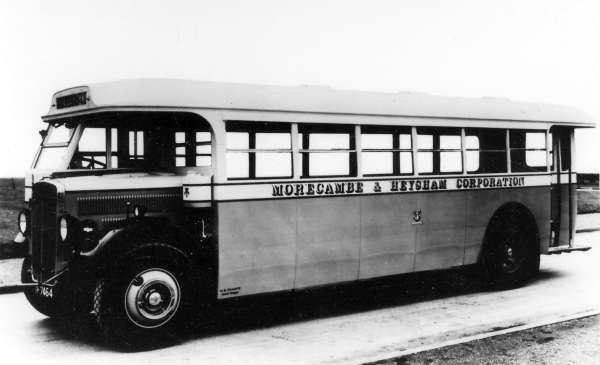
Fleet number 1 registration TF 7464, 1932 AEC Regal 4 with a Weymann B32R body, commandeered 1939.
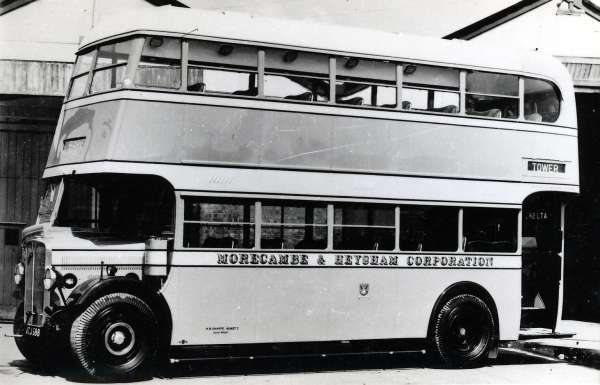
Fleet number 40 registration ATJ 588, 1936 AEC Regent I with a Park Royal H28/28R body, withdrawn 1950.
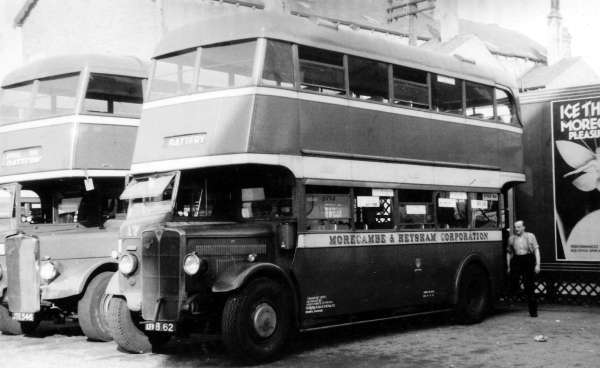
Fleet number 17 registration DTB 62, 1938 AEC Regent I with a Park Royal H28/28R body, withdrawn 1959.
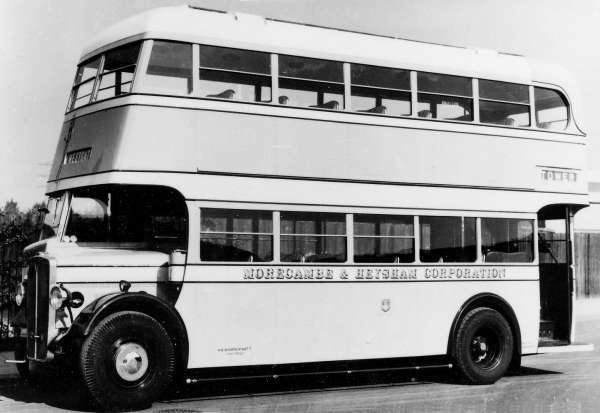
Fleet number and registration number unfortunatly unknown. But it is another of the 1938 DTB batch because of the longer radiator. and dinner plate wheel trims.
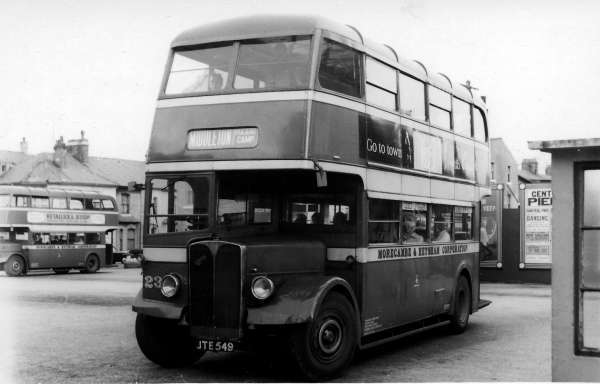
Fleet number 23 registration JTE 549, 1948 AEC Regent III 6811A with a Park Royal H30/26R body upseated to H33/26R 09/63, withdrawn 1968.
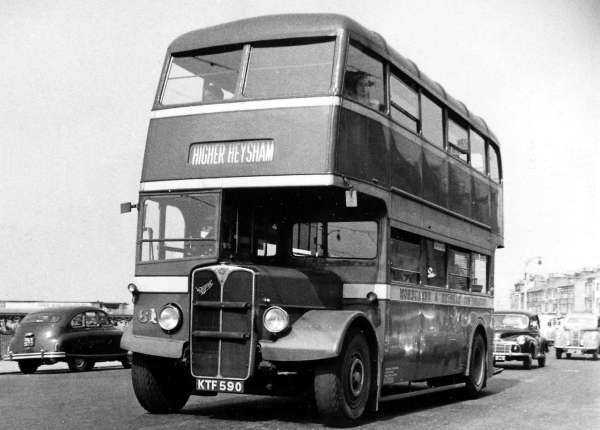
Fleet number 61 registration KTF 590, 1949 AEC Regent III 9612E with a Park Royal H30/26R body, upseated to H33/26R between 09/59 and 03/60. Converted to O33/26R 1968. Transferred to Lancaster City Council Passenger Transport Department
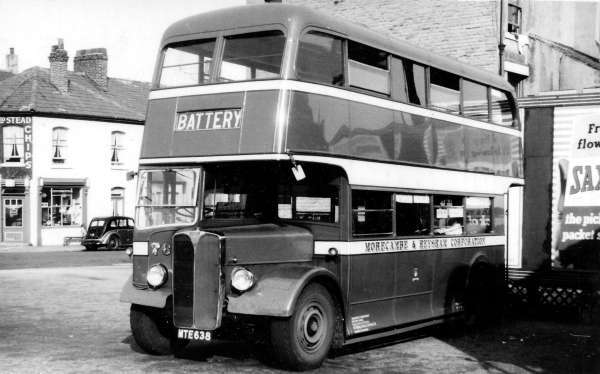
Fleet number 76 registration MTE 638, 1951 AEC Regent III 6812A with a Weymann H30/26R body upseated to H33/26R between 09/59 and 03/60. Transferred to Lancaster City Council Passenger Transport Department as withdrawn 1972.
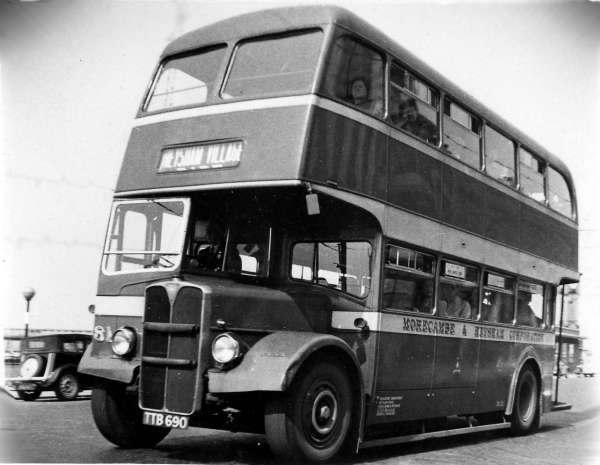
Fleet number 81 registration TTB 690, 1954 AEC Regent III 6812A with a Park Royal H30/26R body upseated to H33/26R between 09/59 and 03/60. Transferred to Lancaster City Council Passenger Transport Department.
All caption information taken from Dave Towers excellent Morecambe and Heysham Corporation fleet list which can be viewed at this link.
None of the above photographs have any markings as to copyright.
14/07/12 - 07:52
Oh, John, you've really outdone yourself with this wonderful gallery. Thank you most sincerely for this great collection of pictures. No wonder you were captivated by these perfect examples of top line vehicles; I'm captivated too, and that's just by the image they conjure up. I was especially taken by the post war Regents, (they're more my period), complete with their evocative radiator blinds. There was nothing better. Completing the atmosphere of nostalgia are the contemporary motor cars in the background - I spotted a Mark 1 Standard Vanguard, A Ford Prefect, a pre-war Morris 10 or 12, and a Morris 8 tourer, (plus the almost obligatory Minor). The nearside front mudguard of 81, however, (bottom photo), makes it look as if it has been driven by someone like me!
Roy Burke
14/07/12 - 11:42
Great photos John. Coming from Halifax - which was a bastion of Regent/Park Royals - I always felt at home in Morecambe, though despite the strong resemblance theirs were undoubtedly of far superior quality to our spindly timber-framed ones.
The preservation group that I was involved with in the seventies bought several Morecambe buses. They had Morecambe 69, and briefly 57, and they were lovely buses to drive. Originally 69 had been bought to dismantle to provide spares for a Halifax Regent, and 57 was for preservation, but then 57's owner suddenly sold it for scrap, so 69 was retained to make amends and is fortunately still around today. Previously 55 had been also bought for spares and I helped to cut it up, and I can vouch that its metal framed body was exceptionally solid. Morecambe's buses always seemed well maintained. Another member bought 80 - one of the great looking lightweight, 7.7/crash box ones - but unfortunately it was burnt out in an arson attack, and another had mechanically similar Weymann-bodied 77. I put in a bid for the one-off 1950 Show exhibit 72, but lost out to a higher bidder. I believe its new owner took it to Carnforth, but I have not heard of it since.
Despite the prewar buses not been 'my era' I have to say that to me the Park Royal-bodied Regents depicted on those official photos represent the ultimate in sheer bus elegance - even if the windscreens must have been far from ideal from the drivers' point of view (or no view).
John Stringer
14/07/12 - 12:38
Thank you John, for your obvious affection, like mine, for this fleet, and your preservation contributions.
I must say, the 9612E Regents, in Morecambe as well as Bradford, were the smoothest and quietest buses I have ever known. In Morecambe, they just oozed pure quality.
You mention the Halifax "spindly" variety, which, as a Bradfordian, I remember well, as they were unlike any Park Royal post war product I have seen. Were they the only post war composite Park Royals?
One puzzling feature discussed amongst a few of us away from this site, is the reason why M and H purchased 2 batches of 9.6/preselector Regents, and then reverted to the 7.7/crash configuration. I cannot find written evidence on this subject, but there are enthusiasts out there who are more knowledgeable than me on the subject of Morecambe and Heysham....I am largely "nostalgia driven" !
Finally, I must discount any thanks for photograph provision. I have several books, plus SOME photos on the subject, but these were all kindly provided by "mine host", who was aware of my interest.
John Whitaker
14/07/12 - 18:13
I've been undertaking an exercise converting some old VHS video tapes to DVD and this afternoon was watching one issued relating to Lancaster City Transport's last days in August 1993. It featured the preserved "Twentibus", Regent III 20 (JTE 546), sister of one of the vehicles in this gallery. At the time of the 1974 merger Morecambe was said to have the country's oldest fleet with hordes of Regents over 20 years old!
Dave Towers
15/07/12 - 12:50
John, I believe that in the late forties Park Royal built both metal and composite framed bodies, just as they had throughout most of the thirties. There were also both four and five bay styles - the four bay ones all being metal framed, but I believe that the five bay ones could be either.
Halifax would have placed more Regents in service in the early 1940's to replace the early open staircase ones, but the war put paid to that. Unusually they chose not to take any utilities, so by the end of the war the fleet was in a bit of a state and they were desperate for a large intake of new buses. My father's cousin Jack worked as a driver at Halifax in the immediate postwar period and recalled the older buses being completely worn out and falling to pieces.
An order was placed for buses to be delivered over the next four years or so and the appropriate sum of money was set aside by the council, but the price kept going up and there were no further funds available. Rather than reduce the number of buses on order, it was decided that the only way was to reduce the specification to keep the cost per bus the same. Park Royal then had to base them on the wartime utility composite frame, eliminating the window pans, leaving the painted wooden pillars exposed to the elements, and mounting the glass directly into the frames - rather like a garden shed. The utility outline was softened by incorporating a rear roof dome derived from the prewar style, and the front end was given the more curved profile of the contemporary standard body. Park Royal must have felt rather ashamed of them as they carried no form of the builder's identification anywhere. From quite early on they gave trouble structurally and required much remedial work, which must have negated any savings made originally, but there had been no choice at the time.
There were other similar(ish) looking Park Royal bodies. London Transport's later relaxed utility Daimlers looked similar, and I seem to recall some Walsall rebodied Guy Arabs and Barrow Corporation PD2's that resembled them a bit, but no other operator (fortunately for them) had exactly the same bodies.
Interestingly, the specification of the 18 Roe-bodied examples in the fleet was never compromised, and they were far superior, yet puzzlingly were amongst the first to go.
Mechanically of course they were brilliant, and the ideal bus for Halifax's mountainous routes, and being a bit lighter in the bodywork they performed really well. The 9.6/preselector Regent III was also virtually standard with many neighbouring operators with hilly terrain - Hebble, Bradford, Huddersfield, Leeds, Sheffield and Rochdale.
Despite the obvious deficiencies of our 'spindly' Park Royals, from a purely hopelessly nostalgic point of view, their unique character and distinctive livery made them part of the Halifax landscape of my childhood.
I visited Morecambe many times throughout the 1960's on family days out and bus club visits, and during the 1970's until the last ones went and, as I said before, the town seemed like home from home to me, though its terrain and leisurely timings were hardly taxing for its Regents. The only thing that spoilt them was when they introduced that horrible wishy-washy final two-tone livery, which I would nominate as being one of the worst municipal liveries ever.
I suppose the 9.6/preselector combination was really a bit over the top for them, and the later 7.7/crash types were more than capable, as well as cheaper to buy and operate.
John Stringer
15/07/12 - 17:20
John, I have so often wondered about the spindly Halifax Mark 111s, and you have answered a long posed question very succinctly for me, for which many thanks! I must have known that Halifax never had any utilities, but never put "two and two together" in that way. I do well remember the outside staircase Regents, some of which were built by Hoyal (another question...who and where were they from?), and we always drove through Halifax to get to Lancashire in those days, so the fleet was different, and exciting, with its "Glasgow" livery.
I remember an EE bodied Halifax Regent in the early 1950s, running for Everingham Bros. of Pocklington, and, of course, holidays in Brid and Skipsea brought me into contact with the Halifax Regents at White Bus Service, a favourite amongst contributors to this site.
Back to Morecambe, I too resented the wishy washy later green livery, and the deceleration of interest was enhanced by the introduction of Massey bodywork (nothing against Massey...it was just "not Morecambe"), and the final straw was the purchase of Leylands....nothing against them either, but in Morecambe? Really!
John Whitaker
16/07/12 - 06:33
I have just remembered that ACP 421, one of the "spindly" Halifax variety of Park Royal Regent 111s, was sold in 1962 to West Bridgeford UDC, to replace an accident damaged metal framed mark 111 of their own. Coming onto WBUDC, I am further reminded of their similarity to Morecambe, with their long standing loyalty to the AEC/Park Royal combination, and also, that it was the furthest north that I can trace any Reading bodywork!
The 1947/8 WBUDC Mark 111s are visually very similar to the M and H variety, except for being 7ft.6ins wide, and having half drop front upper deck windows.
Another fascinating little fleet!
John Whitaker
16/07/12 - 12:20
There is a picture of the ex-Halifax Regent at West Bridgford - see page 2 of the Halifax stream. As mentioned there, it had received a modification to strengthen the spindly upstairs front windows. In view of Halifax's urgent need for new vehicles after the war owing to its non-use of Utilities, it is perhaps surprising that 4 JOC and 7 Corporation pre-war Regents were sold to Nottingham City Transport in 1947 and 48, and survived there until 1954. This might suggest that the Halifax fleet was in sufficiently good condition at the outbreak of war that they didn't need (or at least couldn't make out a convincing case to the MOWT for) an allocation of Utilities. It also suggests that the fleet was still in reasonable condition even after the depredations of the war.
Stephen Ford
16/07/12 - 16:05
A dream come true for John W, who I know has had a love for the M & H buses all his life. I wonder however what the M & H drivers felt about the fleet. One day being rostered on a AEC Regent III 9612E with a 9.6 litre engine and pre-selector box and the next day on a AEC Regent III 6812A with a 7.7 litre engine and a crash box. The drivers' lot was not an easy one in my view, but wonderful for the enthusiast.
Richard Fieldhouse
16/07/12 - 16:06
Until about 1930 most bus types were lucky to last only a few years before they were worn out. or just completely outdated. Then the introduction of chassis like Regals/Regents and Tigers/Titans changed all that, but even then some of the earlier ones, though having chassis capable of double their predecessors' lifespan, still had bodies that were falling apart long before that time. By the mid-1930's bodies such as those by Roe, Park Royal, Weymann and Metro-Cammell were a lot more durable, but I think it took managers of the 'old school' a long time to realise that buses from that era were capable of much longer lives, and so stuck rigidly to a fixed life policy of no more than 12 years – probably determined by the length of two Certificates of Fitness I would imagine.
Halifax began withdrawing its open-staircase Regents and early Regals in the late 1930's, but then due to wartime restrictions many had to carry on until after the hostilities. I am reliably informed that by then many of these were very creaky and tired indeed, and in dire need of replacement. Many of the mid- and late-1930's Regents (some having metal-framed bodies) were probably not that bad at all – nothing that a good overhaul would not sort out – but the department was probably wedded to the idea of a 12-year lifespan and would have wanted to be getting rid of the last ones by about 1950.
As Stephen suggests, many of these were sold on for further service to operators such as Nottingham, PMT, White Bus of Bridlington, Corvedale Motors etc., and gave a few more years good service. Despite this, a few did soldier on with Halifax until replaced by CVG6's in 1954, and the last three plodded on – rather gruffly and noisily as I recall – until 1958.
At the same time as these last three went, wholesale withdrawals began of the Regal/Regent III's dating from only late 1946/1947 (the Regals were even newer). These too were only approaching their 12th year, and were all 9.6 litre/preselector types. Some had the 'spindly' Park Royal bodies (a term incidentally coined by the PSV Circle's Yorkshire sub-editor, the late, great Mike Walker, and one which I though most aptly described them), but some – including eight with RT chassis – had what one have imagined would be sound Roe teak-framed bodies. Strangely it was some of the Park Royals that survived the longest – including some of the 8 feet wide batch which were apparently worst of all. The final (7ft. 6in.) one (277) dragged it out until the 70th Anniversary Procession in 1968, after which it was sold to Tony Blackman for preservation (I think to the consternation of Geoffrey Hilditch and against all his advice) to whom credit must be due to keeping it going on and off until the present day.
The other Halifax-based operator - Hebble - also started to withdraw its Roe-bodied 9.6/preselector Regent III's from 1958, and many of these went only for scrap, though a former Hebble employee once told me that the earliest ones had not been teak-framed due to timber shortages, so may have been of an inferior quality – unusually for Roe. Maybe the Halifax ones had been likewise - maybe someone can confirm this.
John Stringer
29/07/12 - 16:25
We in Lancaster, with our mixed (but increasingly Leyland-biased) fleet always thought M&H a little odd. This was the Council generally, not just the Transport Department with its love of AEC vehicles.
The two authorities did not "get on" and they joined forces with Ribble on the University services with some reluctance. A or B plus Ribble was just about palatable, but A working with B was well beyond reason.
I have been advised that the shotgun marriage of April 1974 was highly traumatic for both parties, but I had moved to Hampshire by then.
That final livery of the M&H fleet was introduced at about the same time as the Swifts, and many would regard its level of attractiveness - and utility - as somewhere near that of the pinks and greys of one of the present big groups.
Pete Davies
Comments regarding the above are more than welcome please get in touch via the 'Contact Page' or by email at obp-admin@nwframpton.com
If you have any bus related photographs that you would like to appear in a gallery on this website please send them to me by email at obp-admin@nwframpton.com
All rights to the design and layout of this website are reserved
Old Bus Photos from Saturday 25th April 2009 to Wednesday 3rd January 2024